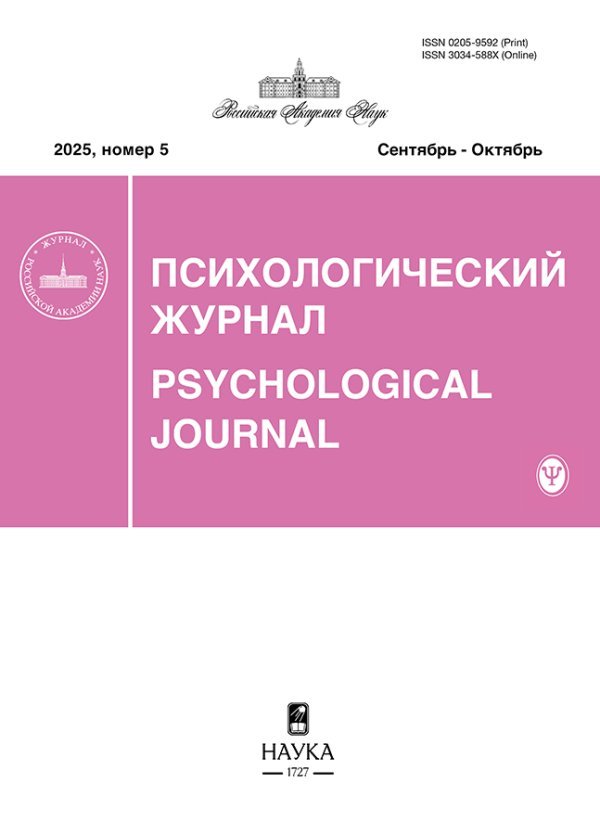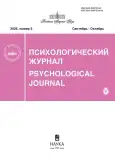The Role of Narrative Transportation in the Psychological Impact of Film (Using the Example of Prejudice Reduction Toward Migrants)
- Authors: Kubrak T.A.1, Starostina A.A.2
-
Affiliations:
- Institute of Psychology RAS
- State Academic University for the Humanities
- Issue: Vol 46, No 5 (2025)
- Pages: 23-31
- Section: Social psychology
- URL: https://stomuniver.ru/0205-9592/article/view/696880
- DOI: https://doi.org/10.31857/S0205959225050033
- ID: 696880
Cite item
Abstract
This study continues a series of works dedicated to the exploration of narrative transportation – a unique state of involvement and immersion in a narrative. Objective: to examine the role of narrative transportation in the psychological impact of film, focusing on changes in prejudices toward migrants. The study involved 184 participants (M = 19.21, SD = 1.14, 31% men and 69% women). The following methods were used: Transportation Scale, Positive and Negative Affect Scale, Questionnaire for the measurement of prejudices towards migrants, the Tolerance Index, Emotional Empathic Tendency Scale, the Need for Cognition Scale, and BFI-2-S. The stimulus material used was the film Stars (2018, drama). According to regression analysis, predictors of narrative transportation included positive affect, empathy, need for cognition, and tolerance. After watching the film, a significant reduction in prejudices was found, particularly regarding perceptions of threat from migrants and in groups with high prejudice levels before viewing. The study also shows that narrative transportation amplifies changes in prejudice, regardless of their initial level. After watching the film, which depicts the challenges faced by migrants, attitudes toward them improved. The higher the level of transportation into the film, the greater the shift in prejudices. Empathy and positive affect are the most significant predictors of transportation. The study demonstrates the potential of film as a tool for psychological impact, especially when there is a high degree of involvement in the narrative.
About the authors
T. A. Kubrak
Institute of Psychology RAS
Author for correspondence.
Email: kubrak.tina@gmail.com
129366, Moscow, Yaroslavskaya st., 13, Russia
A. A. Starostina
State Academic University for the Humanities
Email: starostina.alyona@gmail.com
119049, Moscow, Maronovsky per., 26, Russia
References
- Konstantinov V.V., Osin R.V., Babaeva M.V., Bedrina E.B., Kirdyashova E.V., Klimova E.A. V chuzhoj strane: Social’no-psihologicheskaya adaptaciya trudovyh migrantov v Rossii: monografiya. Ed. V.V. Konstantinov. Moscow: Pero, 2022. (In Russian)
- Kubrak T.A., Starostina A.A. Approbation of the Russian version of Transportation Scale (TS)/ Psikhologicheskii zhurnal. 2023. V. 44. № 4. P. 83–93. URL: https://doi.org/10.31857/S020595920027087-1 (In Russian).
- Kubrak T.A., Starostina A.A. Narrative Transportation as a Factor of Psychological Impact of the Movie. Cultural-Historical Psychology. 2023. V. 19. № 4. P. 26–33. URL: https://doi.org/10.17759/chp.2023190403 (In Russian).
- Latynov V.V. Psihologiya kommunikativnogo vozdejstviya. Moscow: Institute of Psychology RAS, 2019. (In Russian)
- Mishkevich A.M., Shchebetenko S.A., Kalugin A.Y., Soto C., John O. The Short and Extra-Short forms of the Russian version of the Big Five Inventory-2: BFI-2-S AND BFI-2-XS. Psikhologicheskii zhurnal. 2022. V. 43. № 1. P. 95–108. URL: https://doi.org/10.31857/S020595920017744-4 (In Russian).
- Osin E.N. Izmerenie pozitivnyh i negativnyh jemocij: razrabotka russkojazychnogo analoga metodiki PANAS. Psihologija. Zhurnal Vysshej shkoly jekonomiki. 2012. V. 9. № 4. P. 91–110. (In Russian)
- Psihodiagnostika tolerantnosti lichnosti. Eds. Soldatova G.U., Shajgerova L.A. Moscow: Smysl, 2008. (In Russian)
- Shchebetenko S.A. Psihometrika russkoj versii shkaly potrebnosti v poznanii. Vestnik Permskogo universiteta: Filosofiya. Psihologiya. Sociologiya. 2011. № 6. P. 88–100. (In Russian)
- Appel M., Richter T. Transportation and need for affect in narrative persuasion: A mediated moderation model. Media Psychology. 2010. V. 13. № 2. P. 101–135. URL: https://doi.org/10.1080/15213261003799847
- Bilandzic H., Sukalla F. The role of fictional film exposure and narrative engagement for personal norms, guilt and intentions to protect the climate. Environmental Communication. 2019. V. 13. № 8. P. 1069–1086. URL: https://doi.org/10.1080/17524032.2019.1575259
- Brock T.C., Balloun J.L. Behavioral receptivity to dissonant communication. Journal of Personality and Social Psychology. 1967. V. 6. № 4. P. 413–428. URL: https://doi.org/10.1037/h0021225
- Bruneau E., Kteily N., Laustsen L. The unique effects of blatant dehumanization on attitudes and behavior towards Muslim refugees during the European refugee crisis. Journal of Experimental Psychology: General. 2018. V. 147. № 5. P. 691–708. URL: https://doi.org/10.1037/xge0000396
- Cacioppo J.T., Petty R.E., Kao C.F. The efficient assessment of need for cognition. Journal of Personality Assessment. 1984. V .48. P. 306–307.
- Fuller A.G. Narrative transportation in documentary film: How immersion into the documentary film Hillbilly affects viewers’ attitudes. Thesis MS (Journ.). West Virginia University, Morgantown. 2022. URL: https://doi.org/10.33915/etd11230
- Gordon R., Ciorciari J., van Laer T. Using EEG to examine the role of attention, working memory, emotion, and imagination in narrative transportation. European Journal of Marketing. 2018. V .52. №1–2. P. 92–117. URL: https://doi.org/10 .1108/EJM-12-2016-0881
- Green M.C., Appel M. Narrative transportation: How stories shape how we see ourselves and the world. Advances in Experimental Social Psychology. 2024. V. 70. P. 1–82. URL: https://doi.org/10.1016/bs.aesp.2024.03.002
- Green M.C., Brock T.C. The role of transportation in the persuasiveness of public narratives. Journal of Personality and Social Psychology. 2000. V. 79. P. 701–721. URL: https://doi.org/10.1037/0022-3514.79.5.701
- Green M. Transportation into narrative worlds. Entertainment-education behind the scenes: Case studies for theory and practice. Eds. L.B. Frank, P. Falzone. Palgrave Macmillan, 2021. P. 87–102.
- Gulevich O.A., Sarieva I.R., Prusova I.S. Ethnic Prejudices in Russia: Questionnaire Adaptation for the Measurement of Prejudices towards Migrants. Psychology. Journal of the Higher School of Economics. 2015. V. 12. № 2. P. 112–132.
- Igartua J.-J., Cachón-Ramón D. Personal narratives to improve attitudes towards stigmatized immigrants: A parallel-serial mediation model. Group Processes & Intergroup Relations. 2023. V. 26. № 1. P. 96–119. URL: https://doi.org/10.1177/13684302211052511
- Lazić A., Žeželj I. A systematic review of narrative interventions: Lessons for countering anti-vaccination conspiracy theories and misinformation. Public Understanding of Science. 2021. V. 30. № 6. P. 644–670. URL: https://doi.org/10.1177/09636625211011881
- Meade T. What moves you? Testing personality characteristics for transportability in entertainment. Journal of Mass Communication and Journalism. 2015. V. 5. № 9. P. 1–6. URL: https://doi.org/10.4172/2165-7912.1000274
- Oliver M.B., Dillard J.P., Bae K., Tamul D.J. The effect of narrative news format on empathy for stigmatized groups. Journalism & Mass Communication Quarterly. 2012. V. 89. № 2. P. 205–224. URL: https://doi.org/10.1177/1077699012439020
- Oschatz C., Marker C. Long-term persuasive effects in narrative communication research: A meta-analysis. Journal of Communication. 2020. V. 70. № 4. P. 473–496. URL: https://doi.org/10.1093/joc/jqaa017
- Owen B., Riggs M. Transportation, need for cognition, and affective disposition as factors in enjoyment of film narratives. Scientific Study of Literature. 2012. V. 2. № 1. P. 128–149. URL: https://doi.org/10.1075/ssol.2.1.08owe
- Paluck E.L., Porat R., Clark C.S., Green D.P. Prejudice reduction: Progress and challenges. Annual Review of Psychology. 2021. V. 72. № 1. P. 522–560. URL: https://doi.org/10.1146/annurev-psych-071620-030619
- Paravati E., Fitzgerald K., Green M.C., McAllister C., Moore M.M. Narratives to increase prosociality toward refugees. International Journal of Communication. 2022. V. 16. P. 2551–2572.
- Pettigrew T.F., Tropp L.R. How does intergroup contact reduce prejudice? Meta-analytic tests of three mediators. European Journal of Social Psychology. 2008. V. 38. № 6. P. 922–934. URL: https://doi.org/10.1002/ejsp.504
- Tal-Or N. The effects of co-viewers on the viewing experience. Communication Theory. 2021. V. 31. № 3. P. 316–335. URL: https://doi.org /10 .1093/ct/qtz012
- Tchernev J.M., Collier J., Wang Z. There and Back Again? Exploring the Real-Time Cognitive Journey of Narrative Transportation. Communication Research. 2023. V. 50. № 3. P. 312–337. https://doi.org/10.1177/ 00936502211018577
- Tiede K.E., Appel M. Reviews, expectations, and the experience of stories. Media Psychology. 2020. V. 23. № 3. P. 365–390. URL: https://doi.org/10.1080/15213269.2019.1602055
Supplementary files










